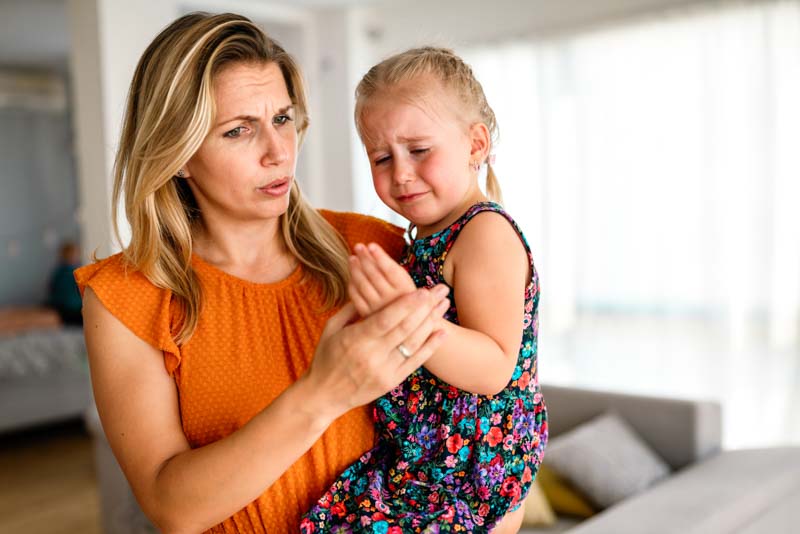Seeing your child in pain is one of the hardest parts of parenting. It’s up to you to discover the issue, solve the problem, and keep everyone safe. That responsibility is heavy, especially if you feel unequipped. This article is meant to provide the information you need to care for your child in the event of a bee or wasp sting. If you’re wondering, “How do you know if your child is allergic to bee stings?” or “What is the best way to treat a wasp sting in a kid?” then you’ve come to the right place.
How to know if your child is having an allergic reaction
Roughly 7% of the population is allergic to bees and wasps.4 For those who are severely allergic, symptoms can appear rapidly and be deadly. Since children are often experiencing their first stings, it is incredibly important to watch for allergic reactions.
Please keep in mind that severe allergic reactions often do not occur the first time someone is stung. So, be careful to not dismiss signs of distress if your child appeared fine with a previous bee or wasp incident.
Initial Signs of Anaphylaxis
Anaphylaxis can occur within minutes after contact with an allergen. If you notice any of the following symptoms in your child, use a prescribed epinephrine pen and call 911 immediately:
- Swelling of the throat
- Difficulty breathing
- Widespread hives
- Vomiting
- Irregular heartbeat
- Heart failure
Symptoms to Continue Observing
After making sure your child is not experiencing anaphylaxis, take note of their other symptoms. Stomach pain, watery eyes, runny nose, and increased swelling are not typical insect sting symptoms. Instead, these indicators may help you know if your child has an allergy. For now, continue observing your child in case a delayed anaphylactic response occurs.

BeST WAYS TO TReAt A CHILD STUNG BY A BEE OR WASP
After examining your child’s initial reaction, you can move onto treating the sting site. If they were stung by a wasp, there will not be a stinger to remove. But if the child was stung by a honey bee, you will need to scrape the stinger out of their skin. Then, treat any bothersome symptoms with at-home first aid.
Removing the Stinger
Usually, we recommend the use of a credit card or other flat-edged item. But children in pain often have difficulty staying still. If they agitate the stinger, it is possible that the sac will release more venom and increase the reaction. So, if you don’t have a tool on hand, use your fingernail to scrape the stinger out. Never squeeze.
Managing Uncomfortable Symptoms
If your child can keep ice on the sting site, it may help reduce the swelling. Otherwise, child-approved antihistamines can help as well. If itchy, kids are prone to scratch their wound. Make sure to watch for this behavior and prevent it if possible.

HOW TO KNOW IF YOUR CHILD IS ALLERGIC TO BEE STINGS
The only way to truly know your child’s allergic risk is by working with an allergist. Through symptom history and testing, the doctor can determine how severe the allergy is and offer appropriate treatment options.
Your Child’s Symptom History
Oftentimes, severe allergic reactions do not occur on the first interaction with an allergen. Instead, each subsequent reaction may worsen until an anaphylactic epsiode takes place. Normal symptoms after a bee sting include itchiness, slight swelling, and a red welt. Anything else should be brought to an allergist for consideration.
Your Child’s Test Results
Stinging insect allergies can be tested in two ways: blood and skin testing. With a blood test, medical professionals are able to measure the amount of specific IgE antibodies to determine allergic risk. Skin testing first requires dropping a small amount of venom onto an area of gently-scratched skin. Then, depending on the results, testing may increase to injecting minimal amounts of venom under the skin. These tests help inform the allergist of the severity of the allergy and how to create the best personalized treatment plan. You can learn more by reading our bee sting allergy testing articles.

WHen to seek help for your child's bee sting
We’ve covered how to know if your child is potentially allergic to bee stings and how to give at-home care. For good measure, let’s go over when to ask for help. Bees and wasps may be small, but their venom can be a big cause for concern.
Emergency Room or 911
Always call 911 if your child shows signs of distress like difficulty breathing, loss of consciousness, and heart failure. Less obvious signs of a deadly allergic reaction include full-body hives, vomitting, and irregular heartbeat. Don’t wait to see what happens next.
Urgent Care
If your child’s symptoms are extremely uncomfortable, consider taking them to an urgent care for an opinion. It’s always better to ask for help, and sometimes anaphylaxis can be delayed. Let a medical professional determine the best next step.
Allergist or Family Doctor
After some time has passed, reflect on the incident. If your child exhibited unusual, or even slightly concerning issues, take it up with your family doctor. Ultimately, we recommend chatting with a local allergist to learn more about testing and treatment options. You might need your pediatrician to provide a referral.
An emergency room, urgent care, or family doctor may only provide information on epinephrine pens. While epinephrine is incredibly helpful during a reaction, venom immunotherapy can prevent a reaction from happening at all. Depending on the age of your child, this treatment may not be a fit now. But with a 98% effective rate, it’s worth checking with an allergist.3






